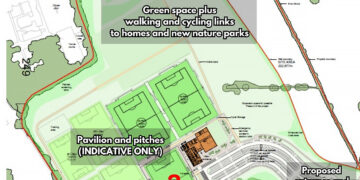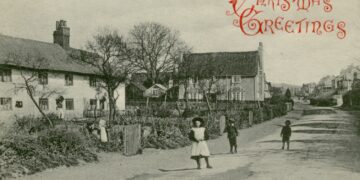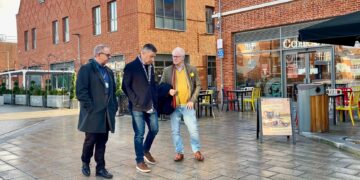In the Wokingham Paper of November 17, we printed a special commentary by Tony Johnson about the future of the borough and the local plan. There was more! Here is Tony’s full, uncut article complete with links, add-ons and more information.
Make sure you have your say and leave your thoughts at the bottom of the article
Resistance is Pointless? – No!
Not quite the Vogons’ battle cry when they destroyed planet Earth to make way for a intergalactic construction project, but close.
If you believe development is inevitable, you’d be forgiven for thinking that you’ve neither choice nor voice in the matter of construction projects around the Borough.
But you’d be wrong.
So we’ve included a handy jargon buster to help you understand Vogons, as well as ‘the plan’.
No, that’s not a ‘cunning plan’, (no turnips here). it’s the Local Plan, currently undergoing a mid-term review and the reason it’s important is that you’ve a chance to influence that review.
Simple Choices – Hard Decisions
Make no mistake, this is about population growth, from reproduction as well as migration and there are some tricky questions to consider.
On housing, should the new houses be spread evenly across the Borough or lumped together on one or two sites?
On services, be it care homes, childcare, dentists, doctors, hospitals or schools, should they be built into the borough or sourced from outside?
On Shops, Offices & Industrial areas, where should they be located and how much do we want (or need)?
On green spaces and leisure activities, can we afford to keep and sustain them, or are they simply places that some future Local Plan will have to gobble up?
On infrastructure, be it travel (by road or rail); water (wanted or not); or utilities; what should we be doing so that we can enjoy our lives without being jammed or deafened, flooded or powerless?
So what’s WBC doing?

Wokingham Borough Council’s recent ‘Call for Sites’, along with an ‘Expression of Interest’ for a new village in Grazeley have triggered criticism and much wailing and gnashing of teeth.
The map shows where approximately 250 suggested places for possible development are located, resulting from the ‘Call for Sites’. Of these, 85% are for housing and site sizes vary; from a dozen small plots each with space for just one new house; to three huge areas, each capable of taking six to seven thousand.
At the moment, all the sites are coloured orange, so one can’t easily tell which ones are for Leisure; Industrial; Retail; or mixed development.
Also for now – nothing has been decided and it certainly isn’t the case that every one of the sites on the map will get developed, creating Chokingham into the bargain.
Problems, like the population, have grown
Back in the 1960’s, despite howls of protest at the time, the one way system was introduced into Wokingham’s town centre because it was jammed solid. By the early 70’s there was a plan to introduce an Inner Distributor Ring road – the IDR. Luckily, it never went ahead.
There were a few industrial buildings along Molly Millars Lane. They’ve grown & grown into a whopping great industrial estate – right in the middle of the town. Access is “problematic” as huge trucks have to use a mix of residential streets or the town centre to get there and residents have to put up with the consequences.
Currently, there’s a plan which calls for over £19M to be spent making access easier by building a road and a new railway bridge and removing the car dealership from the junction of Molly Millars Lane and the Finchampstead Road.
Meanwhile in the town, Retail in Wokingham’s town centre has been “challenging” for at least five decades. Despite the difficulties of lack of parking; high rents and rates; a move to out of town retail parks; the internet’s influence on buying habits; the Borough Council has bravely embarked on a £100M Regeneration project to rectify things.
Whether or not you agree with the decisions, credit where it’s due – the current administration is trying to fix the historic problems.
Learning the game
Computer gamers may recall SimCity, an open ended city-building computer game launched in 1989, which allowed the player to found and develop a city from a greenfield start.
Along the way, the player learnt how to balance residential, commercial, retail, & industrial development with infrastructure and utilities to provide a varied and attractive environment where citizens have work rest and leisure, and you as city planner get the job done at the same time as keeping a balanced budget.
Challenging? – yes to the point of captivation – over 35 million players.
Easy? That’s a different matter entirely.
Realistic? Good for basic understanding, but reality’s even more complex.
The Shape of Things to Come

Despite anything you’ve read to the contrary, at this stage in the process Borough Councillors don’t have the new Local Plan for housing & other developments.
However, they do have a project plan with a timetable, published in September 2015 as the ‘Local Development Scheme’ which describes the key stages to create a Local Plan.
Work on this continues and WBC are currently asking Parish & Town councils for local knowledge to help form an overall assessment of the ~250 possible sites. This consultation runs until mid December.
When the local knowledge is in, an assessment as to the Sustainability of the sites can be made and a “long list” of all the (un!) reasonable options will be published for public comment in 2017, so that a “short list of the preferred options can be published a bit later.
To understand the scale of the challenge, as well as to get your creative thinking going, here’s some ideas as to what should (or shouldn’t depending on your point of view) be used as options for the Local Plan :
The “Thin End – Long Wedge” option
This option is to make a ‘democratic’ spread of houses among the 150 to 200 sites capable of taking them.
Limiting the maximum number of houses on any one site to 200, 100, 50, 20 or 10 (proportional to the size of the site) gives a total of around 12,000 to 16,000 new houses.
However, there’s a couple of headaches that immediately arise.
Locally we average over 2 cars per house, so all the Borough’s key roads would get jammed and by spreading the money so thinly, we won’t be able to afford all the road improvements needed.
Similarly, new residents will need more primary & secondary school places than we’ve got, but because they’re all spread out, there isn’t enough dosh to build schools for every site.
It’s democratic in that it spreads the pain of new houses equally, but plain dumb because it causes the maximum inconvenience to everyone – new and existing residents alike.
Democratic intent, “Dumbocratic” result.
The “Lump Hammer” option
At the other end of the spectrum, one picks one location to develop a new town of twelve to fifteen thousand houses.
For everyone who doesn’t already live on or near that site, this is great!
Unless it affects you on the way to work, or you live there already, then it’s ghastly!
It solves the “spreading money too thinly” problem, giving enough to build or upgrade roads, plus some brand new schools. Affordable housing aplenty. Shops, doctors, and so on.
Except that the developer contributions don’t actually pay for everything that’s needed.
Even if the developer contributions to WBC are alleged to be the “second highest in the country” (hah!), they don’t pay for all the infrastructure that a new town needs.
Guess who pays?
Central government? – perhaps, but that’s a “big ask”.
Local government? – difficult, we’re already £19M off the pace.
You get the idea – it’s the taxpayer who pays and the developers & new home owners who benefit.
As this is a family paper, let’s call this answer “Unicratic”.
Between these two extremes, there’s hundreds of options and it’s unlikely that one answer will please everyone. So, with this in mind, here’s the third option as to how we might move forwards.
The “Fork Handles” option
Trying to apply 21st century planning to an historic town or village is much like putting lipstick on a pig. The end results aren’t pretty and the pig doesn’t like it.
So, instead of the Wedge or Hammer option, perhaps a four pronged approach might share the gains as well as the pains :
- Expand the capacity of chosen main traffic routes with graded developments alongside, allowing room for future expansion.
- Plan the graded developments. Feeder roads go next to the main traffic routes; then heavy industrial & large retail; then light industrial, storage & research; then a linear park, shops, doctors & dentists; lower cost residential, lastly medium to high cost residential served by arterial as well as capillary travel routes.
- Design the infrastructure that support & service the communities one wants to build.
- Move the Molly Millars Industrial estate to alongside a main traffic route. Replace with a mix of residential and retail / indoor leisure (“no-cost-to-park” to attract business).
There are very few places in the Borough where this can be made to work. North of the A329M; A33 south of the M4; M4 junction 9 (not 8/9).
The sharing might be labelled “Partocratic”, so expect factions ahead.
So what do YOU want?
Having a Local Plan gives us the benefit of some local choices as to how many houses of which type go in where, also that the relevant infrastructure can go in the right place at the right time.
In the absence of a Local Plan, Developers have an almost free rein to do what they like. This will be worse than today’s situation.
The Local Plan is probably the most important and emotive topic that we face, short of natural or inflicted disasters. It needs to be sustainable into the generations to come. The options above may be anywhere from great to awful, passing daft along the way.
Our Councillors, be they Parish / Town or Borough are elected to represent our views, but in order to do this, they need to know what those views are.
Your opinion matters – now would be a good time to make contact.
And finally…
If you don’t believe that development is inevitable, then you’ll need to consider how you’re going to hold the tide back OR get some changes made to Government policy, e.g. legislation to apply an “infrastructure first” approach for all development.
You’ll also be able to advise locals about the challenge of dualling or duelling the A33.
One needs a civil engineer.
The other needs a miracle.
~~~~~~~~~~~~~~~~~~~~~~~~~~~~~~~~~~~~~~~~~~~~~~~~~~~~~~~~~
Vogons – Very ordinary guide on new settlements

This jargon busting guide is to help guide you through the main topics that form the rules of our planning system today.
Main items are Hyperlinked so that if you want to know more about something, just click it to get the detail. In general, links are as follows:
Acronyms: Wikipedia entry
Document Titles: Main Web page
xx pages pdf: Separate link to the pdf (where available).
When you look at the web page, you’ll see that there are lots of additional documents, the ones below are just the main ones as an introduction.
Formal Documentation – National Level
NPPF National Planning Policy Framework from DCLG. (50 pages pdf)
Defines central government’s “Presumption to build”
Drives Councils to produce ‘Development Plans’
The NPPF is a ‘Material Consideration’
PPG Planning Practice Guidance from DCLG. (no pdf)
Re-introduced in 2016 (NPPF was allegedly becoming “planning by appeal”)
PPGs are ‘Material Considerations’
DCLG Department for Communities and Local Government (no pdf)
PPG Planning Policy Guidance Notes
Obsolete – replaced by PPS
PPS Planning Policy Statements
Obsolete – replaced by NPPF
Informal Documentation – National Level
Plain English Guide to the Planning System from DCLG (20 pages pdf)
This document is an introduction to the system.
Material Considerations The ONLY topics used for planning decisions
Special Note: The Planning Portal site is run by PortalPlanQuest.
PortalPlanQuest is a joint venture between TerraQuest and the Department for Communities and Local Government.
Formal Documentation – Local Level
Development Plan (DP) The Local Plan – a Material Consideration (when adopted)
WBC’s first DP (2006 – 2026) includes CS & MDD
CS Core Strategy – local policies & strategic plan (139 pages pdf)
MDD Adopted Managing Development Delivery Local Plan (192 pages pdf)
SHMA Strategic Housing Market Assessment
Part of WBC’s Plans Policies & Strategies (WBC29)
Ideal enumeration of future Housing requirements – drives MDD (398 pages pdf)
mid-term review of the Local Plan
LDS Local Development Scheme – the timetable (11 pages pdf)
EOI Expression of Interest for Government Funding
Grazeley EOI, joint venture with other Councils submitted to DCLG
Issues and Options part of LPU – closed Sep 2016 (42 pages pdf)
Call for Sites part of LPU – closed Oct 2016 (23 pages full pdf; 6 pages sites pdf)
Statutes & Regulations – National Level
These are complicated! Please contact [email protected] for more information.
Concluding Observation …
However, if you don’t like all this – Don’t Panic!
Read or watch The Hitchhiker’s Guide to the Galaxy instead.
It’s quicker & possibly more enjoyable (and you get a good description of Vogons too).













































